
PO Box 9021, Wilmington, DE 19809, USA
E-mail: tours@focusonnature.com
Phone: Toll-free in USA, Canada, & Puerto Rico 1-888-721-3555
or 302/529-1876

PO Box 9021, Wilmington, DE 19809, USA
E-mail: tours@focusonnature.com
Phone: Toll-free in USA, Canada, & Puerto Rico 1-888-721-3555
or 302/529-1876
A
FIERY-THROATED HUMMINGBIRD
photographed during a FONT tour
in Costa Rica.
This species occurs there high in the mountains.
ITEMS OF INTEREST:
2010 was the 20th Year for FONT Birding & Nature Tours
AN UPDATE REGARDING THE VERY RARE CRESTED IBIS
During our Costa Rica Tours in March 2010, February 2011, & March
2012, we visited where ALEXANDER
SKUTCH lived.
Click here for:
a FEATURE about him, his writing, & a gallery of NEOTROPICAL BIRDS
![]()
FONT E-NEWS, February 2011: A COSTA RICA tour with over 300 species of birds
FONT E-NEWS, January 2011: our annual Winter JAPAN tour
FONT E-NEWS, December 2010: In the CAYMAN ISLANDS, a Nice Mix of Flora & Fauna
Earlier FONT E-MAIL Bulletins in 2010
The above link to E-News relating to FONT tours conducted in: Arizona, Brazil, Colorado, Costa Rica, Japan, Nebraska, Sonora (Mexico), Wyoming.
A Chronological List of Upcoming FONT Birding & Nature Tours
Narratives & Photo Galleries relating to Past FONT Tours
![]()
FONT E-News, Volume 21, Number 4
March 2011
from Focus On Nature Tours
Lesser Antilles in the Caribbean - February 2011
Approximately 400 species of
birds occur in the West Indies in the Caribbean Sea.
Just over a quarter of them are migrants that occur as transients or winter
residents from North America.
About 300 species of birds nest in the West Indies, and more than half of them
(about 170 species) are endemic to the Caribbean. Of those, nearly 100 are
endemic to one island.
During the FONT
Caribbean Tour, just completed, in February
2011, there were 2 such endemic birds that are not often seen: the Barbuda
Warbler, and the Guadeloupe Woodpecker.
To see both of these birds, a special effort must be made. One must go to those
islands where they are, as the birds do not leave them.
Barbuda is a very small island, with only 48 square miles, located about 30 miles north of the island of Antigua. Actually, the name of that country is Antigua & Barbuda, but those two islands are very different from each other. Nearly 100,000 people live on Antigua. Just over 1,000 people live on Barbuda.
We went from Antigua to Barbuda by boat, from A to B on the C, on a vessel called "the Barbuda Express". There were only a few people on the boat, along with many vegetables, fruits, and other food for those who either inhabit or visit the little island.
On that little island of Barbuda, there really are more creatures of various sorts than people. Most obvious were the donkeys and horses that roam freely. Out in the bush, there are Fallow Deer and Wild Boar (both introduced from Europe years ago).
When we traveled back to Antigua from Barbuda, on a small plane, we could see from the air that on nearly all of Barbuda, there are no roads. A single road goes north from the one small town, and another dirt road, or two, go south.
Throughout the island, Helmeted
Guineafowl, brought from Africa years ago, occur in the scrubby countryside,
usually but not always hidden.
But the rest of the birdlife of Barbuda is native (other than the Eurasian
Collared Dove that has invaded there, as it has other places).
What is said to be the largest
nesting colony of Magnificent Frigatebirds in the Western Hemisphere, is
in mangroves on the island.
At the limestone cliffs at the north end of the island, we saw not a single
person, but we did see a few dozen Red-billed Tropicbirds that were there
to nest. We entered a cave by a white sandy beach and a beautiful blue sea, and
climbed up to the top of the cliffs, where, that one morning, we were eye to eye
with the flying tropicbirds. Being so, was truly a special experience at a
spectacular place.
As we looked out toward the sea and the soaring tropicbirds and diving pelicans ahead of us, there were, below us and behind us, cacti and agaves. And among those plants there were birds such as the Pearly-eyed Thrasher, Antillean Crested Hummingbirds, and the ubiquitous Bananaquit.
During our 2-day stay in Barbuda, there were both West Indian Whistling Ducks (locally called "Whistlers") and White-cheeked Pintails (red-billed ducks that have also been called "Bahama Pintails").
But the bird that is unique to
the island, occurring no where else in the world, and thus drawing us there to
such an idyllic place, is the Barbuda Warbler.
It looks rather like a Grace's Warbler of western North America and south
to Nicaragua, with a yellow eye-line and a yellow eye-ring.
Until not that long ago (in 2000), the bird was called the Adelaide's Warbler, with 3 geographically distinct populations: one in the more arid part of Puerto Rico (mostly in the southwest part of that island), one in Saint Lucia in the southern Lesser Antilles, and one on the little out-of-the-way island of Barbuda, in between, but no where near, either the Puerto Rican or Saint Lucian populations. Those 3 subspecies were quite isolated from each other.
Now, with revised bird taxonomy,
it is the 3 species of the Adelaide's Warbler, as it is still called in
Puerto Rico, the Saint Lucia Warbler, and the Barbuda Warbler,
that are quite isolated.
It is estimated that the population of the Barbuda Warbler is about 1,000
birds (not much different than the human population of the island). That of the
bird is thought to be declining.
Also isolated from other birds similar to it, is the Guadeloupe Woodpecker, a species endemic to that Caribbean island.
Guadeloupe is an overseas prefect of France. It has 2 senators and 3 deputies in the French parliament in Paris. The license plates on the mostly small vehicles are as those in France. The money is as that in France, the Euro. Of the hundreds of thousands of tourists who visit Guadeloupe each year, mostly for its beaches, far and away most are from France.
It's interesting to note that back in 1763, Louis XV of France ceded Canada, a large country, to England, in order to keep the small West Indian islands of Guadeloupe and Martinique, with the Treaty of Paris. The thousands of tourists from France who annually visit the French Antilles surely must appreciate that bit of history.
The French name of the Guadeloupe
Woodpecker is "Tapeur", from "taper" meaning
"to tap", or "to strike, bang, or beat".
Of the more than 200 species of woodpeckers in the world, there are things about
the "Tapeur" that set it apart from the others.
It has a reddish-purple breast and belly, but often the bird appears all-black.
In flight, the bird does not undulate as woodpeckers normally do.
Its call is also distinctively its own, a loud "ch-arrgh" given by
birds in the forest to maintain contact with each other.
Oddly, the closest woodpecker to it, in terms of appearance and structure, is
the Lewis' Woodpecker of western North America. It is in the same genus
as the Lewis', Melanerpes.
But the Guadeloupe Woodpecker is so geographically isolated from others
in the woodpecker family. There are also Melanerpes woodpeckers in the Greater
Antilles and in Central and South America, but there is no other woodpecker of
any kind in the Lesser Antilles.
On Guadeloupe, the "Tapeur" is a rather shy, and often inconspicuous bird of the dense forest and other wooded habitats. It occurs below 1,000 feet above sea level. It is estimated that its population may be 10,000 pairs. The bird does not "flycatch; its diet of insects is taken in dead wood.
A particularly interesting aspect of Melanerpes herminieri, the Guadeloupe Woodpecker, is that the length of the male's bill is 20 per cent longer than that of the female. During our tour, we were fortunate to see a pair, together, in a bare tree, and that notable difference in bill length could easily be seen.
Another interesting bird for us on Guadeloupe was the Plumbeous Warbler. That species is a two-island endemic, occurring only on Guadeloupe and Dominica, where we also saw it during the tour.
Other birds that we enjoyed during the portion of our February 2011 tour in Dominica were the two Amazon parrots endemic to that island, the Imperial and the Red-necked Parrots, the beautiful hummingbird known as the Purple-throated Carib, the maybe even more beautiful Blue-headed Hummingbird, the usually secretive Forest Thrush, and the Rufous-throated Solitaire with a song that's beautiful, as if from a flute in the trees.
A distinctive bird that we saw was a thrasher called a trembler, as it has an odd habit of shaking its wings. Hence, it has the name Brown Trembler. That bird was seen on Dominica, while another member of its family, the Scaly-breasted Thrasher was observed on both Dominica and Guadeloupe. Yet another member of the thrasher tribe, the Tropical Mockingbird, was on Guadeloupe. At the very northern end of that species' range in the Caribbean, it was found singing its rich song in scrub habitat by a beach.
Some of the birds during our
tour occur on most, or even all, of the Lesser Antillean islands. Thus they have
that appellation of "Lesser Antillean", included in their
common names as an adjective.
On Dominica, Lesser Antillean Swifts flew in the sky above us.
On Dominica and on Guadeloupe, Lesser Antillean Flycatchers posed in
trees near us.
On Guadeloupe, we saw the Lesser Antillean Saltator.
On every island we visited, there were Lesser Antillean Bullfinches. That
little bird would often join us for breakfasts in open restaurants (or those
even with just an open door).
The Bananaquit would also
come to some of our breakfast tables. That species ranges from the Bahama
Islands south to Argentina. In that extensive range, there are 41 subspecies. 24
of those subspecies are on Caribbean islands.
On the islands we visited in February 2011, the Bananaquits were of the
subspecies Coereba flaveola bartholemica, with the normal
Bananaquit coloring of black, white, and yellow, with red in their open mouths.
Bananaquits on two other Caribbean islands, by the way, that we have
visited in the past, lack the white and yellow, being all-black.
During our February 2011 Tour,
on the island of Antigua, a Broad-winged Hawk was found sitting
quietly in a tree where the foliage was dense.
The 5 subspecies of Broad-winged Hawks on West Indian islands are
residents, not ever coming in contact with those of the same species in eastern
North America.
The resident Caribbean subspecies occur in Cuba, Puerto Rico, and in the Lesser
Antilles. Of those subspecies, the one on Antigua, Buteo platypterus
insulicola, has the smallest range, being endemic to just that one island.
It is said to be smaller and lighter than any other subspecies of Broad-winged
Hawk. Also notable about it is that it is the only bird (as a subspecies)
endemic to the island of Antigua.
After the sun set, on the remote, quiet island of Barbuda, in the otherwise dark night-time sky, the profusion if stars was brilliant. The thousands of stars, from first to sixth magnitude, were magnificent as was the band of the Milky Way across the sky. To look up at Orion in February, without being cold was nice indeed. Looking at it, through binoculars and seeing the nebula was great. To the eyes (even those of a person getting older), there were, as jsut noted, thousands of stars. With the binoculars, there were thousands more.
Being out at night, I thought how nice it would be to hear an owl. There were the sounds of frogs, but I realized that there are no owls, any longer, anywhere in Antigua & Barbuda. And it's now the same for Guadeloupe.
There were, until about the end
of the 19th Century. There were 2 subspecies of the widespread Burrowing Owl:
the Antigua Burrowing Owl, Athene cunicularia amaura and the Guadeloupe
Burrowing Owl, Athene cunicularia guadeloupensis. Both are now extinct, and
both, it's written, became so by 1900. The culprit with both is said to have
been the introduced animal, the Mongoose.
The Guadeloupe Burrowing Owl was actually on an offshore Guadeloupe
island known as Marie Galante.
The Antigua Burrowing Owl was on the islands of Antigua, Nevis, and St.
Christopher (St. Kitts).
Burrowing Owls still
exist on Caribbean islands on Cuba, Hispaniola, and in the Bahamas.
From a few specimens, it is known that the isolated Guadeloupe and Antigua
Burrowing Owls were darker than others in the West Indies.
Offshore from Antigua, 35 miles,
there's actually a third island in that country with the name of two islands,
Antigua & Barbuda. That little island is called Redonda, a rocky
volcanic islet. No people live on that island, but seabirds, of various kinds,
nest there such as Red-footed and Brown Boobies and Brown
Noddies.
But in the "Caribbean Islands Handbook" there's a most fascinating
note (that seems erroneous based on everything else I've read). Certainly, it's
intriguing. the note: "Redonda is well-known for its burrowing owl,
now extinct on Antigua".
As just indicated, no one lives there. And as of yet, I don't know anyone who's
ever been there.
After referring in this essay to island birds, and ending with some that have gone extinct, a concluding statement or two is appropriate:
Among the bird species listed by Birdlife International (of the U.K.) as being at risk of extinction throughout the world, nearly half (46%) are island species.
And since 1600, 93% of all the bird species and subspecies that have become extinct, globally, are island species.
There may not be as many species of birds during tours in the Caribbean as there are some other places, but those that are there are certainly worth seeing.
And we enjoyed during so on the West Indian islands we visited in February 2011.
Some Postscripts to the above
Caribbean narrative:
1) Nature other than birds was also observed during our Feb '11 Caribbean Tour:
The island of Guadeloupe,
from high in the air, or on map, has the shape of a butterfly.
Among the butterflies that we saw on that picturesque island, in addition
to the common Whites, Yellows, and Blues, there was a
beauty called the Red Rim, Biblis hyperis, and some of the local
population of Monarchs, Danaus plexippus.
Monarch butterflies in
the Caribbean, that have been treated as races or subspecies, are resident and
do not migrate.
Land mammals are few and far between on Caribbean islands, with most being those with wings, that is various bats, and those that have historically been introduced.
We noticed a raccoon as
an emblem on signs for the large Guadeloupe Natural Park (an area of forested
hills and volcanoes). It has been called the Guadeloupe Raccoon.
But recent studies (from 1999 to 2005) have determined however that the animal
on Guadeloupe is actually the subspecies of the Northern Raccoon from the
Bahamas. That subspecies, Procyon lotor maynardi, is an endemic on New
Providence Island in the Bahamas, other than the population transplanted on
Guadeloupe. It is said to have been brought there by humans "a few
centuries ago".
When the Guadeloupe Raccoon was considered a valid subspecies, it was Procyon
lotor minor. When it was said to be a distinct species, it was Procyon
minor.
With whatever classification, it is a rare animal on Guadeloupe, with a small
and declining population estimated at about 2,000 individuals.
On Barbuda, a mammal that was seen not brought there by humans was the Greater Bulldog (or Fishing) Bat, doing that, fishing, after dark at a pond where the Whistling Ducks were doing that, whistling.
While the number of land mammal
species in the West Indies is low, that of amphibians and reptiles
there is high, with a large number of endemics on the various islands.
During our tour, there were Watt's Anole and Griswold's Ameiva on
Barbuda and Leach's Anole there and on Antigua. Those lizards are
endemic to Antigua & Barbuda.
We also saw the attractive, green Leopard Anole, endemic to Guadeloupe.
On both Barbuda and Antigua, there were Lesser Antillean Whistling Frogs.
On Barbuda, we came across a Red-footed Tortoise (called locally the
"land turtle"), not native on Caribbean islands, having been
introduced from South America where it is widespread.
Seashells on the beaches
of Barbuda are varied and interesting. None of us dove or snorkeled but the underwater
marine life there is said to be varied and interesting as ell.
2) More regarding the island of Redonda:
Historically on that small rocky
islet it was guano that was the draw, in those days an important
ingredient in the making of explosives. The guano was from the large numbers of terns,
boobies, pelicans, and frigatebirds that contributed to the phosphate
deposits.
In 1979, a group of
naturalists, an archeologist, and a geologist went there. They discovered only
two trees as the islet is covered mainly with coarse grass and cactus. The
entomologist tallied 20 species of small moths. A beetle attracted
to seabird guano was discovered. And of course the seabirds were there.
But the party also did find a Burrowing Owl, a species that had
disappeared from Antigua over 80 years earlier!
All the best,
Armas Hill
![]()
FONT E-News, Volume 21, Number 3
February 2011
from Focus On Nature Tours
In February
2011, it was our 30th FONT tour in Costa
Rica, in mostly the highlands of the country.
During that tour, there were about 300 species of birds (303), as
well as mammals, butterflies, and other nature.
Among the birds during the tour: Resplendent Quetzal, Three-wattled Bellbird,
Turquoise Cotinga, and Scarlet Macaw were seen. One of the remarkable
aspects of our Feb '11 tour in Costa Rica was that with each of these species.
both the male and the female birds were nicely seen.
As to the first three, there are distinctive differences between the sexes. The
male and female Scarlet Macaws appear the same, but that species
normally occurs in male-female pairs. We saw, closely, about a dozen Scarlet
Macaws one afternoon, in flight, and feeding in trees atop rocky cliffs by
the Pacific Ocean.
The female bellbird and cotinga are not seen as often as the
males. Our encounter with the bellbird was with a pair in a forest, at
times next to each other on a branch, as the male repeatedly gave its loud call.
At times, the brilliantly blue male Turquoise Cotinga perches in the open
on a bare branch at the top of a tree, but we saw first the female cotinga,
in such a way, before we saw the male.
And with the quetzal we also saw the female before the male. A female
came to a small fruit tree, in the middle of a field, to eat. A short while
later, we saw a male, with its colorful plumage shining in the morning sunlight,
as it sat ever so still at the forest edge. As always, it was wonderful to see
that spectacular species.
Other notable birds during the tour included: Southern Lapwing, White Hawk,
Chiriqui Quail-Dove, Buffy Tuftedcheek, Black-breasted Coquette, and an
array of other hummingbirds, and an assortment of colorful tanagers
and their allies.
Mammals during the tour included 3 species of monkeys, Three-toed
Sloth, and agoutis, coatis, and an animal called an Olingo.
Links:
More about the FONT Costa Rica Tour in February 2011
Lists of Birds & Other Wildlife during the FONT Costa Rica tours - February 2011
Costa Rica Birds (a list of 863 bird species; about 700 during FONT tours- with some photos)
A Photographic Sampling of Colorful Costa Rican Birds
A
Feature about Alexander Skutch, a naturalist in Costa Rica
Upcoming FONT Birding & Nature Tours in Central America
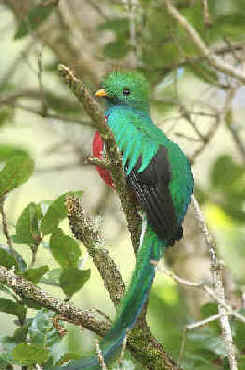
Among the
highlights of the February 2011 FONT Costa Rica Tour
were Resplendent Quetzal (above),
and Scarlet Macaw (below).
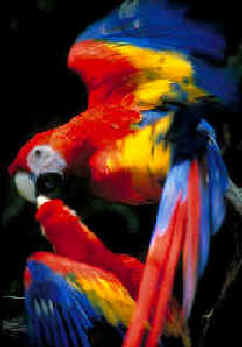
![]()
FONT E-News, Volume 21, Number 2
January 2011
from Focus On Nature Tours
Japan - January 2011
It was our 35th tour in that
country. During the tour, we visited the 3 Japanese islands of Honshu, Hokkaido,
and Kyushu.
In all, 125 species of birds were found: 76 on Honshu, 66 on Kyushu, and 49 on
Hokkaido.
Although in Hokkaido there was
the lowest number of bird species, it was that island, again, with the most
highlights, including cranes, eagles, and the Blakiston's Fish Owl.
The Red-crowned Cranes were observed one nice afternoon, as they stood,
danced, and called on the snow.
At one time by the sea in eastern Hokkaido, we were surrounded by dozens of eagles,
both the White-Tailed and magnificent Steller's, as hundreds of gulls,
mostly Glaucous, also foraged in the same area.
A fine flock of Asian Rosy Finches was on the ground nearby.
Later as that afternoon turned to night, we saw 2 huge Blakiston's Fish Owls.
One of those big birds flew directly over our heads.
Hokkaido also had other notable
birds for us in January 2011, including a Japanese Accentor, both Bohemian
and Japanese Waxwings, an American Wigeon among Eurasian Wigeon,
Falcated Duck, Smew, many Harlequins and other Ducks,
a flock of Lapland Buntings or Longspurs, and some beautiful Bullfinches
of the gray-bellied race.
The Japanese Accentor is a most unusual bird in Hokkaido in the winter.
The Lapland Longspurs were a new bird for the 35 FONT Japan tours,
bringing our cumulative total of species to 393.
In January 2011, we did pelagic
trips onboard ferries both to and from Hokkaido.
During the northbound boat-trip to Hokkaido, we saw Laysan Albatross,
numerous Kittiwakes, other gulls, and alcids.
During the southbound boat-trip, there were Japanese Murrelet, Common
Murre, Red Phalarope, Streaked Shearwater, Pomarine Jaeger,
Northern Fulmar, and various gulls, Pacific Loon, and Pelagic
Shag.
In Kyushu during the winter of
2010-2011, a sad note is that bird flu struck in the flock of thousands of cranes
that come to winter from mainland Asia.
Therefore, entry was restricted to the area of those cranes, mostly
Hooded and White-naped.
Even so, we saw those species well, along with both of the other rarer crane
species there when we were, the Common and Sandhill Cranes.
Of course, the Common Crane is not at all common in Japan.
The Sandhill Crane is the most common crane in the world, with most in
North America, but some breed in Asia in Siberia. In January 2011, we saw 3 Sandhill
Cranes in Kyushu.
The Hooded is the most common of Kyushu's Cranes, with generally
about 9,000.
The White-naped Crane is beautiful bird, graceful for sure. Generally
from about 1,500 to 2,000 of them winter on Kyushu.
Before we arrived in Japan,
about a half-dozen Hooded Cranes and a White-naped Crane had died
from the bird flu. Both species are classified as vulnerable, even without the
flu problem, so let`s hope that their situation relating to the flu improves.
The cranes leave their limited wintering range in Japan in February to return to
their expansive breeding range in China and Russia.
Other birds that we saw in Kyushu included, in reeds, the rare Pallas's Reed Bunting from Asia along with the Common Reed Bunting, which is common, as well as a White's Ground Thrush foraging in leaf litter, and a large flock of Common Shelducks, common at least at that one place.
Other notables during the tour were Mandarin Ducks, always nice to see, as were Japanese Grosbeaks, Hawfinches, Common Kingfisher, Brown Dipper, Azure-winged Magpie, the Japanese Green Woodpecker, Varied Tit, Red-flanked Bluetails, and Daurian Redstarts. As noted earlier, 125 bird species in all.
There were 7 species of mammals during the tour including: the Japanese Macaque (or Snow Monkey), Red Fox, Sika Deer, Northern Fur Seal, Kurile Seal, and, again for us, a second time, Sea Otter. Our first time for that rare animal in Japan was last January, in 2010.
In Hokkaido, where we found our least number of bird species, there was for us the most species of mammals.
And of course, as already said, it was in Hokkaido where we experienced the true avian highlights, including the cranes, swans and ducks, alcids, eagles, and what is said to be the largest and rarest owl in the world.
Just put into the FONT website are some photos of birds taken by one of the
participants on our recent October 2010 tour in Brazil - kindly donated by Bob
from Colorado.
If you'd like to see Scarlet-headed Blackbird, Striped Owl, Jabiru, Coscoroba Swan, Guira Cuckoo, Nanday Parakeet, Plush-crested Jay, and others, there's a link from the home-page in our website.
Also in that group of photos, a bird that was discovered as recently as 1969, and occurring only locally in far-southern Brazil, the Long-tailed Cinclodes.
Wishing you good birding, and all the best, wherever you may be,
Armas Hill
![]()
FONT E-News, Volume 20, Number 10
December 2010
from Focus On Nature Tours
Cayman
Islands - December 2010
This tour in early
December 2010 was to a small, but interesting, island,
Grand Cayman, in the middle of the blue
Caribbean Sea. About 200 miles south of Cuba, and over 150 miles west of
Jamaica, that island is out there by itself, except for the two accompanying
islands in the group of 3, Little Cayman and Cayman Brac.
Of the 3 Cayman Islands, Grand Cayman is, (although as noted as small),
the largest of the 3 with 123 square miles.
Whether perceived as "small" or "large", as already noted
also, Grand Cayman Island is interesting,
with a mix of habitats: dry forest, dry scrubland, seasonally flooded wetlands,
and extensive mangroves.
In that mix on the Cayman Islands, there are, incredibly, 415 types of plants
believed to be native, and among them about 30 that are endemic and about
25 near-endemic. Now, that is interesting!
And that relates to the flora. There's also the fauna. I'll
mention both here, but the flora first:
We saw a number of those native and endemic plants during our tour, including
the Agave caymanensis, Dendrophylax fawcetttii (the critically
endangered Ghost Orchid), Coccothrinax proctorii (the
Silver Thatch - the endemic "national tree" that
played such a part in the island's history), and Hippomane mancinella,
the Manchineel, a tree that, in all of its parts, is very poisonous to
man, but with a fruit that can be eaten by the rare Cayman Blue Iguana.
That reptile is said to be the rarest of the world's iguanas. Native to Grand
Cayman Island, it is now considered to be a subspecies of the Cuban Iguana,
Cyclura nubila lewisi.
Many of the native plants and animals of the Caymans are derived from species on
Cuba, Jamaica, and to a lesser extent, Central America.
Among the amphibians and reptiles during our December
2010 tour, in addition to the iguana, there were, clinging on
large leaves, the Cuban Treefrog, and seen on the ground, the Cuban
Racer, or Ground Snake. The snake was the endemic subspecies on Grand
Cayman Island, Alsophis cantherigerus caymanus.
Among the birds of the Caymans, that we enjoyed during our tour, were
these that occur more commonly in Cuba: the Rose-throated Amazon, Cuban
Bullfinch, LaSagra's Flycatcher, and Western Spindalis.
We saw, nicely, the Yucatan Vireo. Grand Cayman Island is the only place
for that species outside of Mexico and nearby Belize.
The Vitelline Warbler is virtually endemic to the Caymans (otherwise
being only on the isolated Swan Island). And, also during our
tour, we saw about as many as 300 West Indian Whistling Ducks, a species
that globally is rare and elsewhere can be difficult to find.
And there were the unexpected, very unexpected: as we were waiting one
evening, at sunset, for Velvety Free-tailed Bats to leave their
daytime roosting sites, an Eastern Whip-poor-will flew by and a King
Rail called in the nearby tall reeds of a small marsh. Both the whip-poor-will
and the rail are very rare birds in the Caymans (in fact, not even on
the island's bird-list), but they occur in December as either a vagrant in
Cuba and Jamaica (the rail) and (with the whip-poor-will) as a
rarely-observed transient in Cuba on its way to spend the winter by the
Caribbean coast of northern Central America.
Conversely, very easy to observe in the Caymans are butterflies - always
a natural highlight of a visit there, and they were for us again in December
2010, with dozens of Julias (or Flambeaus) at
one place, and a number of other species including the Cuban Red Leaf
Butterfly, Gulf Fritillary, White Peacock, Caribbean Buckeye, the Soldier,
Western Pygmy Blue (possibly the smallest of the world's butterflies),
and the Hanno Blue and Lucas's Blue (closely related to the
rare Miami Blue of south Florida).
Also in the "insect-department" during our December
2010 Cayman Tour, we saw a diurnal moth that looks so much
like a small hummingbird, even having a white band on the lower back as do the
small hummingbirds called coquettes. That moth, that we saw feeding at flowers,
has, of course, a scientific name: Aellopos tantalus. Its English name
is, correspondingly, the Tantalus Sphinx Moth.
And then there was the large caterpillar that we saw that would turn into
a moth. Over 4 inches long, that big, fat caterpillar was, and filled with
color: bright yellow, black, and with a red head. Scientifically it goes by the
name Pseuosphinx tetrio, to be the large Tetrio Sphinx Moth.
During a previous FONT tour in the Caymans, that was in the month of February,
we saw that big moth, flying about after dark, as the headlights of our vehicle
shone on it, when we were on a dark back road. That road, by the way, was not
far, as the moth would fly, from where we saw the caterpillar, a couple years
later, in December 2010.
We look forward, in the years ahead, to going to the Cayman Islands again for
the fine assortment of nature to be had there, on a Caribbean island both
pleasant and comfortably warm.
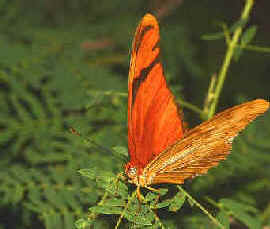
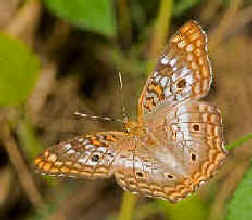
Two of the
butterfly species during our December 2010 Cayman Tour,
the Julia (above) & the White Peacock (below).
Links:
A List of Birds & Other Nature during the FONT Cayman Islands Tour in December 2010
Cumulative List of Birds during FONT Tours in the Cayman Islands
Butterflies in the West Indies of the Caribbean
Amphibians & Reptiles in the West Indies of the Caribbean
![]()
FONT E-News, Volume 19, No. 8
December 2009
from Focus on Nature Tours, Inc.
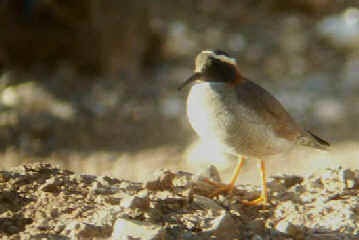
An extraordinary bird, the
Diademed Plover
was seen well
during the FONT Nov/Dec 2009 Chile Tour.
Chile
- November/December 2009
The first Focus On Nature tour ever was in Chile
in November 1990.
19 years later, in 2009,
from November 22 to December 4, we were
there again. Chile was a great destination for our first tour, and in 2009, it
still was!
Our highlights in 2009 were many.
Probably foremost among them was a very close and cooperative Diademed Plover.
When we saw that bird back in 1990, its English name was then the Diademed
Sandpiper-Plover. About 20 years later, in its preferred name, the
"sandpiper" had been dropped. But whatever its common name, that
absolutely striking bird of mostly the high Andes was as much of a thrill for us
to see in 2009 as it was two decades earlier.
Our 2009 tour was the 18th for FONT in Chile.
And, even so, we managed to enjoy a spectacle, and a bird species that we had
never previously seen.
Late one day, with a backdrop of Andean mountains, and purplish-blue twilight
sky, we watched as about 500 Burrowing Parrots arrived at their roost for
the night. Most flew into their burrows. Some perched on snags on the big cliff
that was the dormitory for the birds. Rather like small macaws, the Burrowing
Parrots were so raucously noisy that evening across the gorge from us on the
large cliff. Our evening with them was another highlight of the tour.
And yet more tour highlights were had during our time on Chiloe
Island in southern Chile. During a late-afternoon along the seacoast,
when the weather was absolutely beautiful (it is not always that way on
Chiloe Island), we enjoyed wonderful looks of both Humboldt and Magellanic
Penguins, a family of Kelp Geese, pairs of Fuegian (or Flightless)
Steamer Ducks, both Rock and Imperial Shags, a massive
swarm of shearwaters and other seabirds, and a mammal never
before seen during a FONT tour. That mammal is a counterpart in the Southern
Hemisphere of the Sea Otter in the North Pacific. Smaller than the Sea Otter, it
is called the Marine Otter, or locally, in Spanish, the "Nutria
del Mar" ("of the sea"). It is a rare animal.
Late that afternoon as we were leaving that wonderful seaside-spot, we saw
another animal that's rarely seen. A small and shy deer, called the Pudu,
it was standing still on the right side of a dirt road in front of our vehicle.
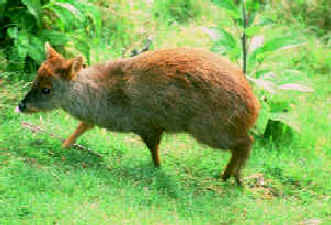
The small, shy Chilean
deer called the Pudu
The next morning,
further south on Chiloe, we walked along the
edge of a mudflat by a sheltered cove of the sea on the east side of the island.
It was a nice place that's certainly found to be so by Hudsonian Godwits
from North America. There were about 2,500 of them, by us, feeding tamely on the
flats.
And yet another highlight of our tour occurred the next day on Chiloe
Island. After we stopped our vehicle and got of it in the forest,
there was a nearby loud call followed by loud tapping. At eye-level very near
us, there were 2 female Magellanic Woodpeckers. We stood rather still,
and we were rather quiet. Another loud call was given, a short while later,
behind us, followed by a male Magellanic Woodpecker flying in, to also be
closely in front of us, at eye-level, and brilliantly seen in the sunlight.
Here in capsule form, were some of the highlights of our 2009 FONT Chile Tour.
You may read more about these birds and mammals, and others, in the narrative
reached from the link below.
Links:
More about the FONT Chile Tour in November/December 2009
List of Birds & Other Wildlife during the FONT Chile Tour - November/December 2009
A
Complete List of the Birds of Chile (with
photos)
Mammals & Other Wildlife in Chile (with photos)
Upcoming FONT Birding & Nature Tours in Chile
A Mystery Storm-Petrel during the FONT Nov/Dec 2009 Chile Tour
During a ferry-boat ride to Chiloe Island, on December 1, 2009, as part of the
FONT Nov/Dec '09 Tour in Chile, some storm-petrels were noticed with more
extensive white than expected on their vents/bellies.
What we did not know at the time was that earlier that same year, another group
of birders, in waters in much that same area, also observed some similar
storm-petrels.
The photos below were taken in the same Chilean waters
a few months before our Nov/Dec '09 FONT tour,
taken in February 2009 by Michael O'Keeffe
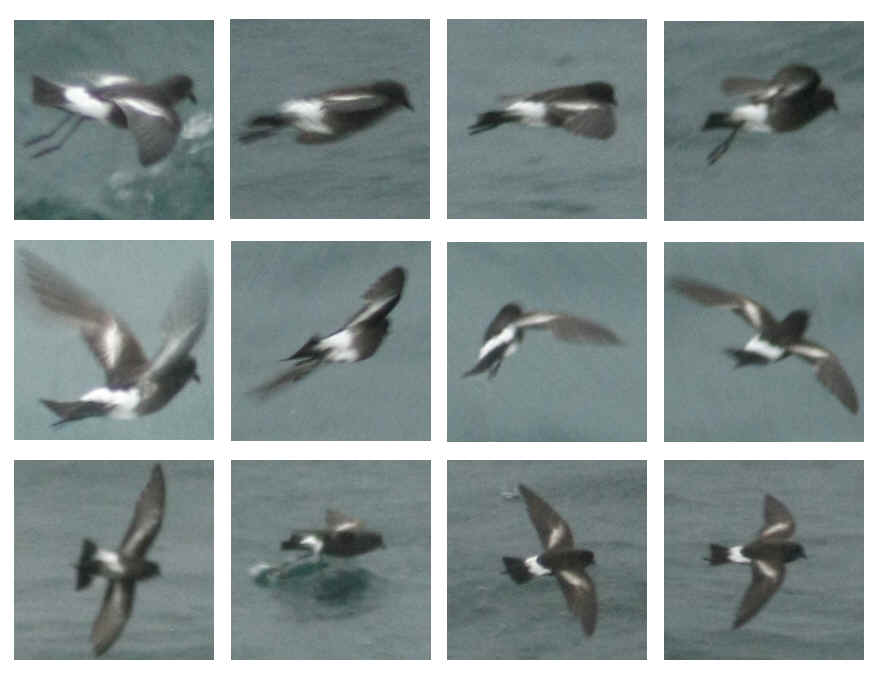
This "mystery
storm-petrel" was seen during the FONT Chile tour
on December 1, 2009 from the ferry to Chiloe Island.
Link:
More
about the Mystery Storm Petrel of South-Central Chile
![]()